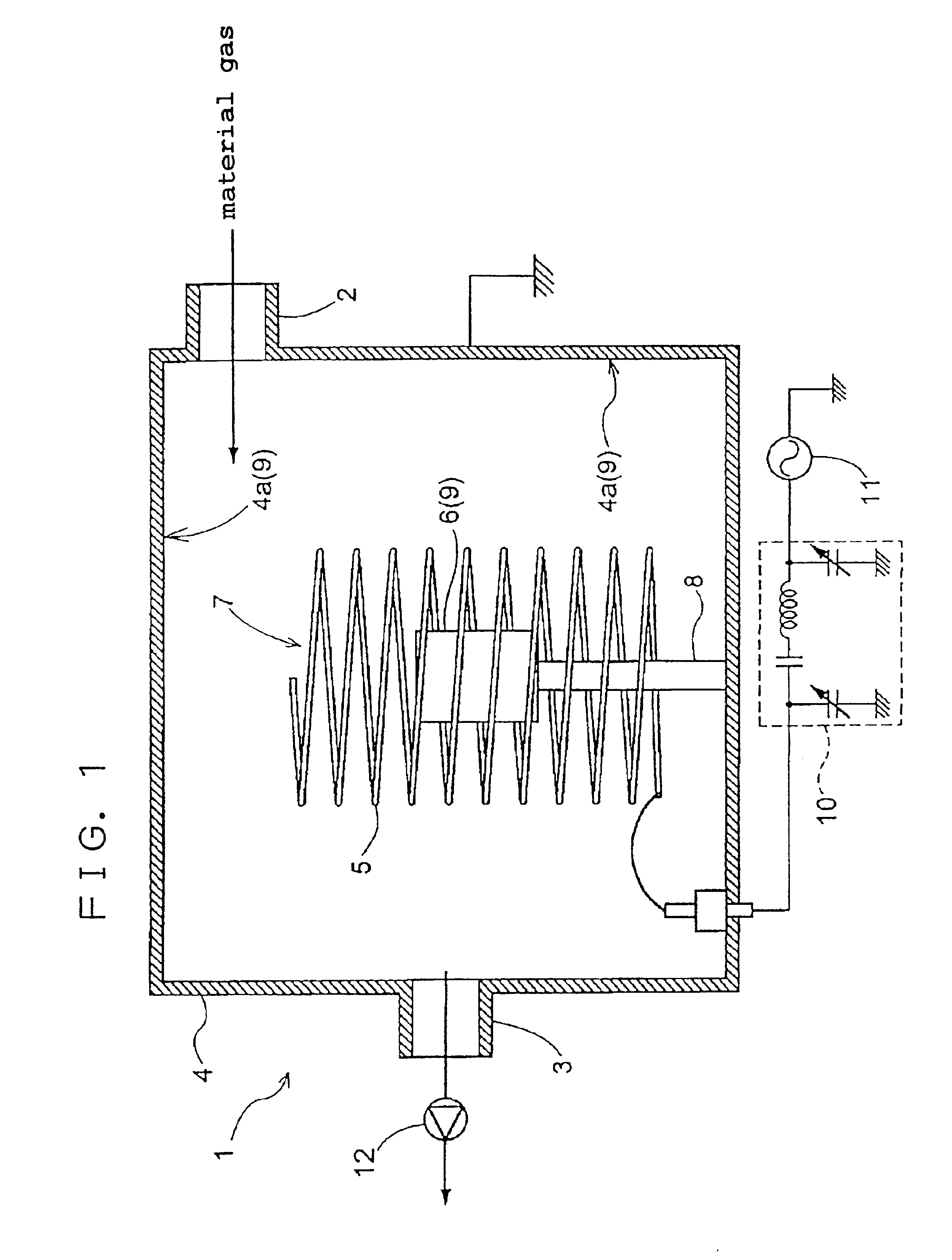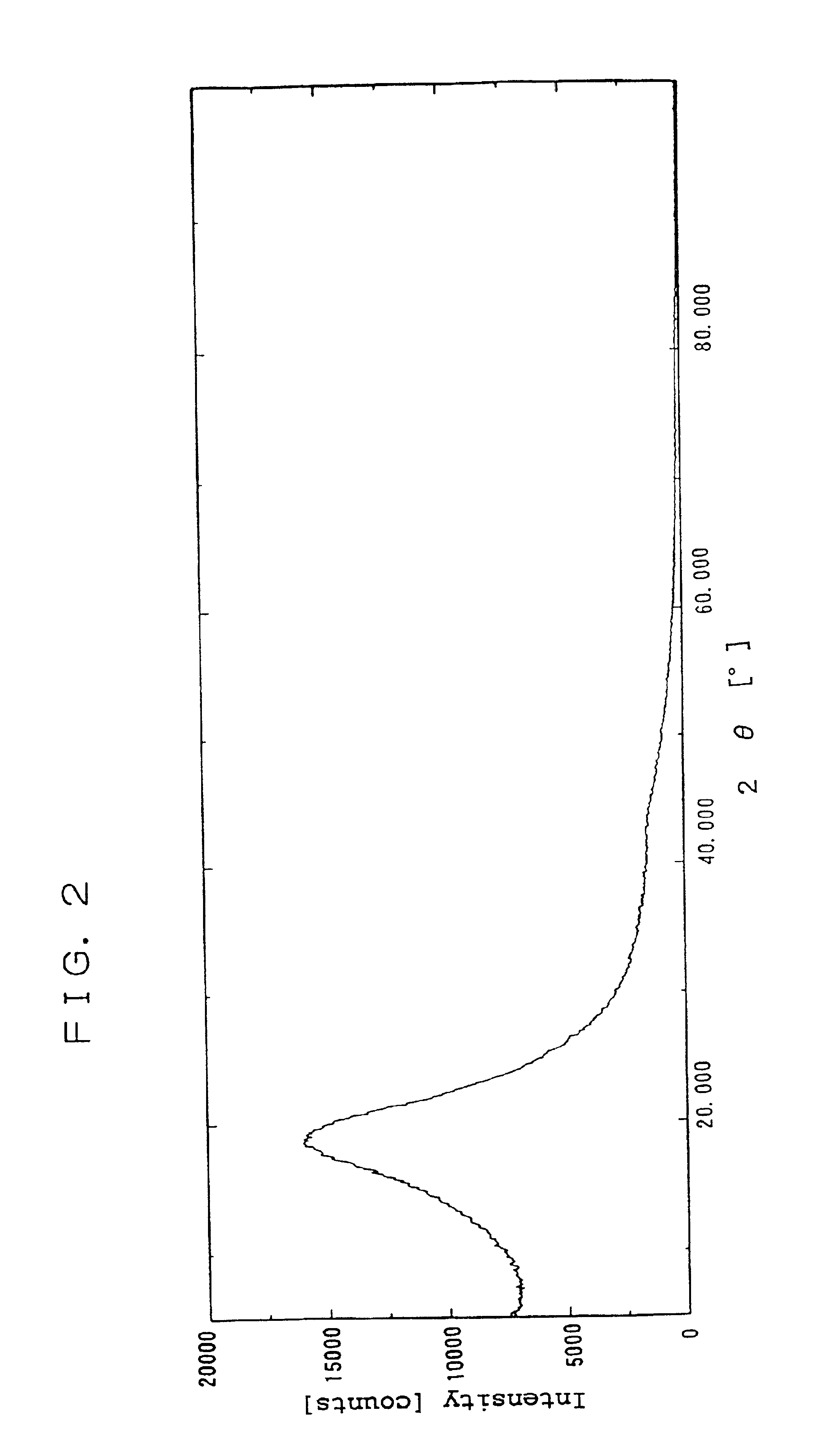Amorphous nano-scale carbon tube and production method therefor
- Summary
- Abstract
- Description
- Claims
- Application Information
AI Technical Summary
Benefits of technology
Problems solved by technology
Method used
Image
Examples
example 1
[0090]10 mg of an anhydrous iron chloride powder (having a particle size not greater than 500 μm) was dusted uniformly over a PTEE film (60 μm×10 mm×10 mm), and the film was then excited by plasma. FIG. 1 shows the outline of a thin film forming apparatus 1 used. It is a matter of course that an apparatus having a structure other than that shown in FIG. 1 can be used in the present invention.
[0091]The thin film forming apparatus 1 shown in FIG. 1 comprises a reactor 4 equipped with a material gas inlet 2 and a gas discharge port 3, a first electrode 5 made of a helical wire and provided in the reactor 4 in an insulated manner, and further comprises a support member 8 electrically contacted with an object 6 and supporting the object 6 within a plasma generation area 7 surrounded by the first electrode 5; the support member 8, in combination with an internal wall 4a of the reactor 4, being electrically grounded to serve as a second electrode 2. Consequently, application of a high freq...
example 2
[0099]10 mg of an anhydrous iron chloride powder (having a particle size not greater than 500 μm) was dusted uniformly over a PTFE film (60 μm×10 mm×10 mm), and the film was placed in a vacuum furnace. The pressure in the furnace was reduced to 0.1 Pa, and then the film was irradiated with a laser beam.
[0100]The conditions for laser beam irradiation were as follows.
[0101]
AtmosphereHeInternal pressure500 torrTemperature800° C.Input laser beam wavelength248 nmInput laser beam power density17 mJ / pulse / cm2Number of cycles of input1 Hzlaser beamPeriod of irradiation with30 minutesthe input laser beam
[0102]After completion of the reaction, formation of amorphous nano-scale carbon tubes was confirmed by SEM and X-ray diffraction. The product obtained in this Example had a diameter and length approximately equal to that of Example 2.
example 3
[0103]10 mg of an anhydrous iron chloride powder (having a particle size not greater than 500 μm) was dusted uniformly over a PTFE film (60 μm×10 mm×10 mm). The film was placed in a vacuum furnace. The furnace was purged with nitrogen 3 times, and the pressure in the furnace was reduced to 3 Pa. Then, the film was vacuum baked at 900° C. for 10 minutes.
[0104]Formation of amorphous nano-scale carbon tubes was observed by SEM and X-ray diffraction. The product obtained in this Example had a diameter and length approximately equal to that of Example 1.
[0105]FIG. 3-A and FIG. 3-B are TEM photographs of an amorphous nano-scale carbon tube obtained. FIG. 4 is an X-ray diffraction chart of the carbon tubes thus obtained.
[0106]TEM observation revealed that, in each of the obtained amorphous nano-scale carbon tubes, the dimension in the planar direction of the hexagonal carbon layers is smaller than the diameter of the carbon tube. The X-ray diffraction angle (2θ) was 18.9 degrees; the spaci...
PUM
 Login to View More
Login to View More Abstract
Description
Claims
Application Information
 Login to View More
Login to View More - R&D
- Intellectual Property
- Life Sciences
- Materials
- Tech Scout
- Unparalleled Data Quality
- Higher Quality Content
- 60% Fewer Hallucinations
Browse by: Latest US Patents, China's latest patents, Technical Efficacy Thesaurus, Application Domain, Technology Topic, Popular Technical Reports.
© 2025 PatSnap. All rights reserved.Legal|Privacy policy|Modern Slavery Act Transparency Statement|Sitemap|About US| Contact US: help@patsnap.com



